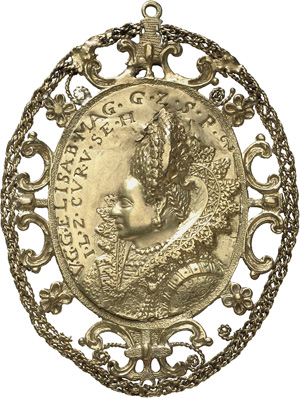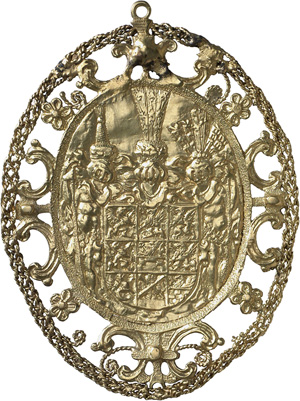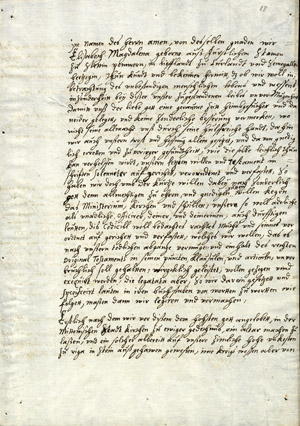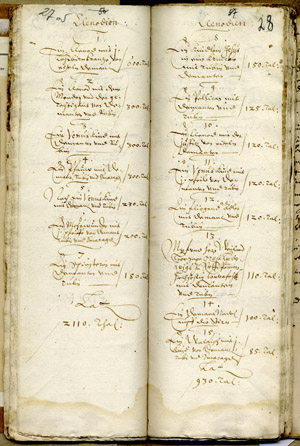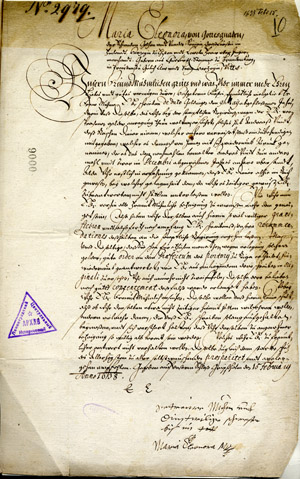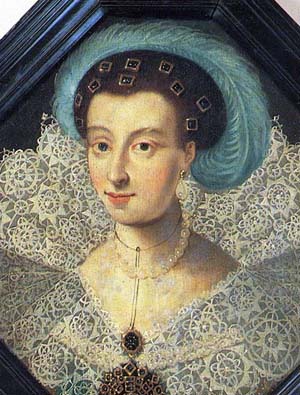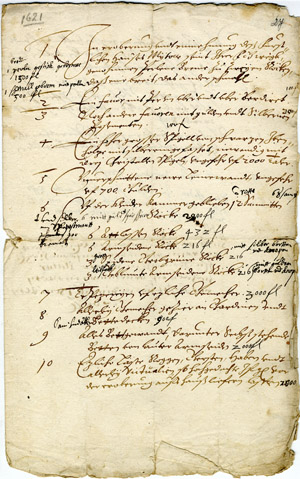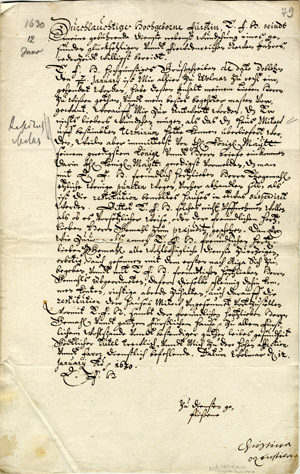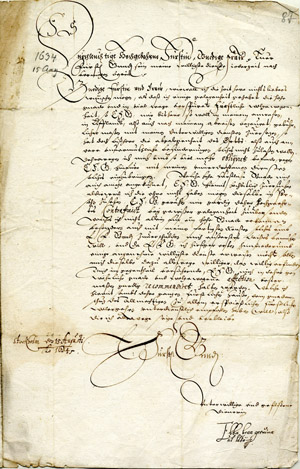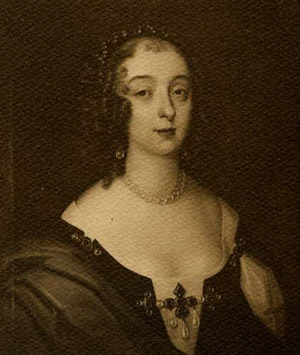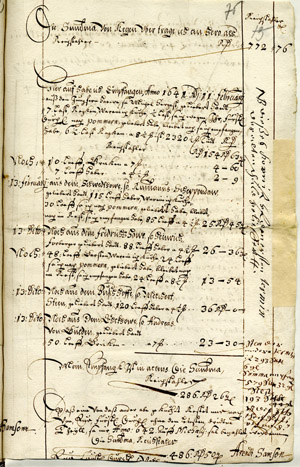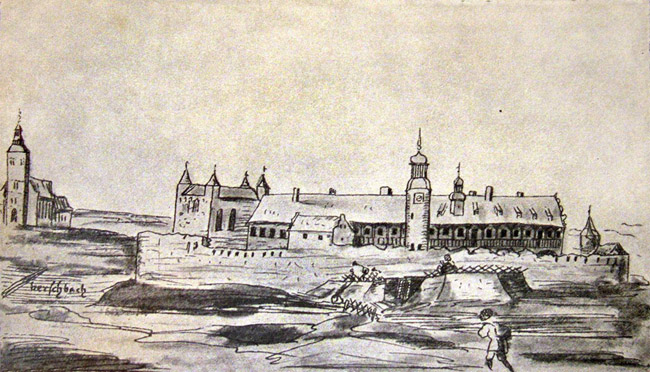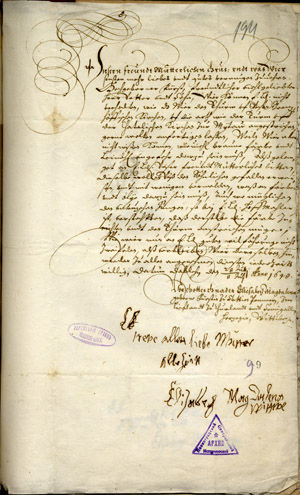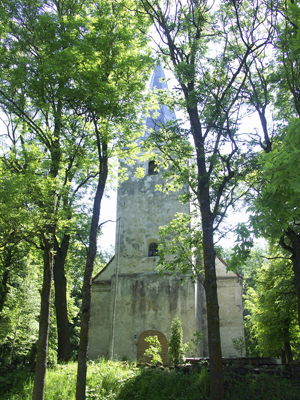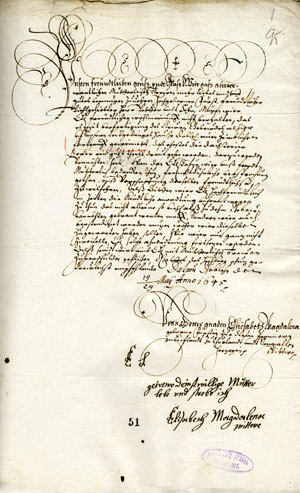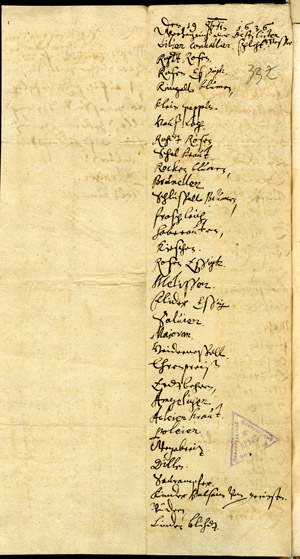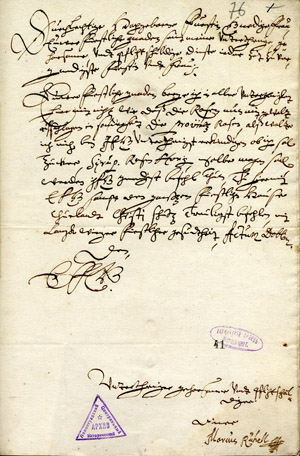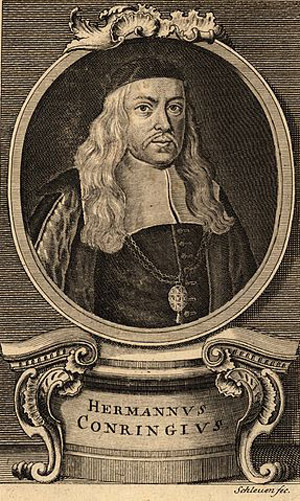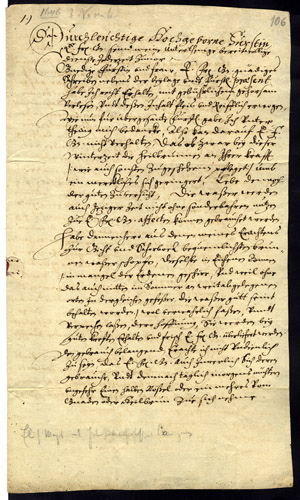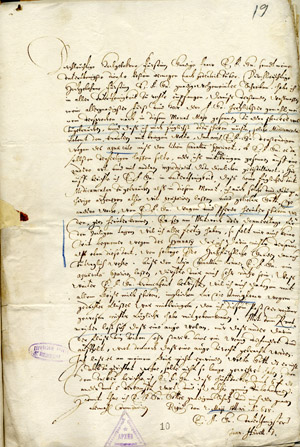Elisabeth Magdalena (15801649)
Duchess Elisabeth Magdalena was born in Wolgast on 17 April 1580. Her father was Ernst Ludwig, Duke of Pomerania-Wolgast, and her mother, Sophie Hedwig, was from Braunschweig-Lüneburg. On 14 May 1600 Elisabeth Magdalena married Duke Frederick, arriving in Courland in the autumn. Her mentality was strongly influenced by the views of her time: she was very pious, but also believed in the Devil, witches and magic. However, this did not prevent the duchess from becoming actively involved in politics. Supporting Duke Frederick's efforts to secure the neutrality of Courland and achieve the recognition of Prince James' right to the throne of the duchy, she corresponded extensively with various rulers and their wives.
Elisabeth Magdalena owned more than 20 manors, the most important being Jungfernhof/Jumpravmuiža, Grenzhof/Mežmuiža, Klein-Friedrichshof/Lipsti and Eckhöfchen/Ozolmuiža near Mitau/ Jelgava. She carefully supervised the management of these lands. The managers of the manors had to report to the duchess several times a week and obtain permission for all the work. On the manors, considerable attention was given to horticulture and medicinal plants. The duchess's apothecaries and she herself used the herbs to make medicines. Elisabeth Magdalena was very accomplished in the art of healing.
Particularly important in the life of the duchess was her dower, namely the castle and manor of Doblen/Dobele. After the death of Duke Frederick and the accession to the throne of James (1642), major building work and improvement was carried out in the castle complex on the instructions of the duchess. Elisabeth Magdalena took up residence in Doblen/Dobele Castle and died there on 23 February 1649.
One of the final acts by the duchess was the founding (or re-establishment) of the town of Jaunjelgava in 1646. In honour of her deceased husband Frederick, she named it Friedrichstadt.
1. Gold medallion with a portrait of the duchess on the obverse. The reverse shows the arms of Pomerania. Original in the Bode Museum, Berlin. Photo: D. Bruģis.
2. Codicil to the will of Elisabeth Magdalena. Mitau/Jelgava, 18/28 June 1638. Written in her own hand. Excerpt. LVVA, Collection 554, Inventory 3, File 34.
Also preserved is the duchess' will (LVVA, Collection 554, Inventory 3, File 34, Pages 2634), compiled at the same time as the codicil. The duchess wished to be buried in the ducal vault of Mitau/Jelgava Castle Church and that the funeral ceremony be led by the court pastor Georg Mancel. Elisabeth Magdalena made her husband Duke Frederick the sole heir. The codicil also expresses the request that an altar be created and erected in Holy Trinity Church in Mitau/Jelgava, if she does not manage to do so during her lifetime, and lists bequests to churches in Mitau/Jelgava, the almshouse and the widows' hospice, and to pastors, courtiers, managers of manors and servants.
3. The family arms of Duchess Elisabeth Magdalena: Pomerania-Wolgast. Stained glass window from Hofzumberge/Tērvete Church. Photo from the collections of Rundāle Palace Museum.
Stained glass windows with the arms of the duchess and Duke Frederick also adorned the windows of the church in Grenzhof/Mežmuiža.
4. List of the dowry of Elisabeth Magdalena. Excerpt. Wolgast, 1599/1600 LVVA, Collection 554, Inventory 1, File 200.
The list takes up 77 pages. It mentions jewellery, fine dress, bed-linen etc., and even two gilded coaches. The total value of the dowry exceeded 50 000 thalers. Listed separately are gifts given to Elisabeth Magdalena by her relatives and the towns of Pomerania. For example, her mother gave her a necklace with diamonds, pearls and a griffin figure, her guardian gave her an ornament “with a cockatoo” and her brother Duke Philip Julius gave her a necklace with the arms of Pomerania and Braunschweig.
5. Letter to the duchess from Maria Eleonora, Queen of Sweden, wife of Gustav II Adolf. Gripsholm Castle, 15 February 1638. LVVA, Collection 554, Inventory 1, File 151.
The queen confirms Sweden's readiness to pay Elisabeth Magdalena 18 000 guilders from the Riga customs duty to redress the losses caused by the Swedish army.
6. Portrait of Maria Eleonora, Queen of Sweden (15991655). Circa 1630.
7. List of losses compiled by Elisabeth Magdalena after the Swedish capture of Mitau/Jelgava Castle. Draft of a demand for recompense submitted to the Swedish government. 1621. LVVA, Collection 554, Inventory 3, File 733.
The list mentions dress embroidered with pearls and gold, tapestries, curtains, blankets, bed-linen, six beds with canopies, an ebony mirror in a silver frame etc. Special mention is made of an altar commissioned for Trinity Church in Jelgava, with sculptures of the duchess and Duke Frederick, having a value of 2000 guilders, which the Swedes had plundered in the stonecarver's workshop in Riga. The losses totalled 29 830 guilders.
8. Letter from Kristina Oxenstierna to Elisabeth Magdalena. Wolmar/Valmiera, 12 January 1630. LVVA, Collection 1100, Inventory 13, File 722, Volume I.
Kristina (16091631) was the daughter of Count Axel Oxenstierna, Chancellor of Sweden (15831654), and the wife of Swedish military leader Gustav Horn (15921657). She writes that, at the behest of the duchess, she has used all her influence in trying to incline her husband favourably towards the ducal house of Courland. Horn has replied that he would gladly return Mitau/Jelgava Castle, captured by the Swedes, to the duke, but that the king objects.
9. Letter from Ebba Brahe to Elisabeth Magdalena. Stockholm, 15 August 1634. LVVA, Collection 1100, Inventory 13, File 722, Volume I.
Brahe was the wife of Swedish military leader Jacob De la Gardie (15831652). In her letter she thanks the duchess for her goodwill, which she has enjoyed during her stay in Livland and after returning to Sweden, and asks for a portrait of the duchess. In another letter, on 2 September 1636, Brahe confirms that she has received a portrait of Elisabeth Magdalena and Duke Frederick.
10. Portrait of Ebba Brahe (15961674).
11. Receipt from Riga merchant Arend Samson. Riga, 1641. LVVA, Collection 554, Inventory 1, File 220.
The merchant had received the grain mentioned in the receipt from the manors of Duchess Elisabeth Magdalena: Jungfernhof/ Jumpravmuiža, Schwethof/Svēte, Klein-Friedrichshof/Lipsti, Eckhöfchen/Ozolmuiža and Grenzhof/Mežmuiža. The total value is 286 thalers. The grain was to be sent by ship to Pomerania.
12. Doblen/Dobele Castle and Church. Drawing by Johann Rudolph Sturn. 1661.
The new Doblen/Dobele Castle was built in the time of Duke Gotthard. Duke Frederick presented the castle and manor to his wife as a gift, also bequeathing it as her dower. The castle complex along with the church was altered in the 1640s on the instructions of Elisabeth Magdalena. Seen at left is the church in the town of Doblen/Dobele.
13. Letter from Duchess Elisabeth Magdalena to Duke James. Dobeln/Dobele, 18/28 July 1648. LVVA, Collection 554, Inventory 1, File 198.
In the letter the duchess tells of the construction of a new church at Grenzhof/Mežmuiža, indicating her wish that the tower should be painted “after the model of the Catholic church in Mitau”, namely red-brown. She also asks the duke to send a non-German (Latvian) apprentice working for the court painter to paint the tower.
14. Grenzhof/Mežmuiža (now Augstkalne) Church. Photo from the collections of Rundāle Palace Museum.
15. Letter from Elisabeth Magdalena to Duke James. Doblen/Dobele, 19/29 May 1645. LVVA, Collection 554, Inventory 1, File 198.
The duchess writes that construction of the new building in Doblen/Dobele Castle is proceeding well. She asks Duke James to order the production of the required number of roof tiles and inform her at which kiln they can be collected. Elisabeth Magdalena also invites James to spend Whitsun with her in Doblen/Dobele, even though not everything is quite ready there yet.
16. List of herbs used for making tinctures. 19 October 1636. LVVA, Collection 554, Inventory, File 195.
The list includes 65 plants, such as dandelion, cowslips, cherries, balm, elderberry flowers, lime flowers, dill, peonies, oak leaves, fennel, lilac flowers, strawberries, salvia, marjoram, rosehips, roses, pot marigolds etc.
17. Letter to the duchess from the court apothecary Mark Ruhell. Doblen/ Dobele, circa 1640. LVVA, Collection 554, Inventory 1, File 219.
Ruhell reports that the roses are blooming splendidly in Doblen/Dobele Castle garden especially the Provence roses. The apothecary asks for directions as to what he should make from the rose petals: “rose sugar, syrup, honey or ointment”. He adds that he is sending the duchess a vessel of redcurrants and three figs plucked by the wind.
18. Portrait of Hermann Conring (16061681).
19. Letter from Hermann Conring to the duchess. Helmstedt, 3 November 1646. Excerpt. LVVA, Collection 1100, Inventory 13, File 722, Volume I.
Conring was a lawyer, historian and medical doctor, one of the most outstanding scientists of his day, Professor and Rector of Helmstedt University. At the behest of the duchess, Conring provided mineral water for curing gout and stomach-ache, promising to send it to Courland in oak barrels. He recommends that this water be used internally and externally, also in the bath-house. If the duchess had no bath, the doctor was ready to explain how to build one. For strengthening the stomach, he suggested Rhenish wine with meals.
20. Letter to the duchess from Johann Hövellius.Riga, 2 May 1638. LVVA, Collection 554, Inventory 1, File 223.
Hövelius was a medical doctor and natural scientist, who was born in Holland and had studied in Leiden, and in 1631 had moved to Riga. He had been the Riga city doctor, a teacher at the Riga Dom Grammar School and the duchess's court doctor. In the letter he writes that he will soon be visiting the duchess and bringing the required medication, and will teach her to make a special infusion from mayflowers.
